Monster Espresso
All I kept thinking to myself, as I tried to blend in like a cat at a dog show was, "I guess Italians and Spaniards really are that good looking." That, and how important a humble little air-cooled two-valve roadster must be to Ducati.
For all the glitz, glam and exposure Ducati's renowned 1098 and its variants have received in the past year and a half, you could almost lose sight of the fact that the Bologna, Italy, bike maker has any other products. Accolades from prestigious motopublications to the average Ducatisti heaped upon the brilliant Twin are deserved; it is a machine that has ratcheted Ducati's name up to the stratosphere on the scale of all things desirable. A home in the South of France, private jet, fine wines, beautiful spouse, exotic automobiles, admiration by those we admire, high-performance Ducati sportbike. Yes, a bright red Duc 1098 (or Desmosedici!) is right at home in that imaginary life.
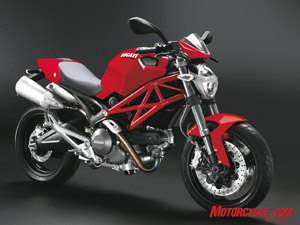
2009 Ducati Monster 696. It comes with the pillion cover and little flyscreen as standard in the States. MSRP will be $8775.
Alas, we're quick to forget the little guy. The glory-grabbing superbikes from Ducati owe much to the sustainability of the Monster line, now 17 years after it was first seen. Ducati knows this. They know it to the point that opening night of the world press introduction for the 2009 Monster 696 in Barcelona was a gala dinner at the Museu D'Art Contemporani De Barcelona, replete with local dignitaries including Italy's ambassador to Spain and all the Ducati chieftains.
Before I sheepishly sneaked away from the dinner table, averting my gaze when any impeccably groomed, tan-skinned persons passed by for fear of them recognizing me the following day by my pauper's toggery, I noted various trademark components of the new bike, large and small, were displayed like the art that many consider them to be. The Monster, it was everywhere.
Though the most recent iteration of the tiniest Monster, the 695, is only two years old, comparing the 695 visually to the 696 makes the former look years older than it is. The round headlamp, uninspired mirrors, trellis subframe hidden mostly from view, traditional and traditionally placed exhaust cans, simple instrument cluster, vanilla indicators and taillight and box-section swingarm, to name a few pieces, simply make the 695, however functional it may be, look unattractive when pitted next to its replacement. The new little Monster is as much an exercise in styling as it is a general improvement.
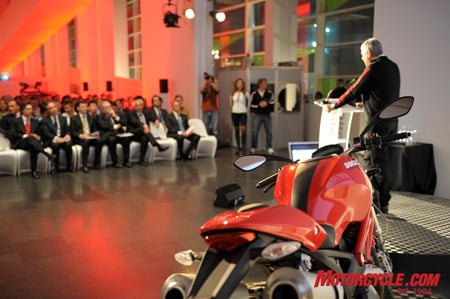
Pete, arriving late to the gala dinner opening night thanks to British Airways, was not dressed like so many of the sharp execs and dignitaries. No, Pete came to the dinner looking like a Venice Beach slacker.
Il nuovo Monster 696: l'inizio di una nuova era!
The 696’s simplified trellis main section is meatier (same stock as the 1098R) and now joins with a cast-aluminum subframe that blends so well that the eye can be fooled into thinking no subframe exists. A new hefty swingarm and unique footpeg hanger complete the package.
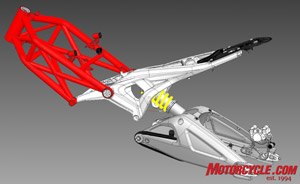 All three pieces of the chassis are new for the 696 and are the heart and soul of the excellent handling of the newest Monster. |
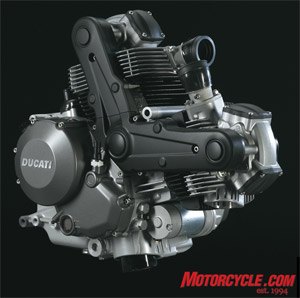 The heart of the Monster. A number of internal changes to the mill result in a claimed 80 hp and 51 ft-lbs, up by 7 and 6 respectively over the 695. |
Overall dimensions remain largely the same save for a minute 4/10ths of an inch increase in the wheelbase (56.7 vs. 57.1); rake and trail are still 24-degrees and 96mm, respectively. One figure that hasn't changed is the rider-friendly 30.3-inch saddle height. Combined with a fuel tank reshaped for narrowness where it meets the seat, the rider triangle has only become friendlier and should be very endearing to the ladies with its easy reach to the bars. Despite a tighter design, cramped never came to mind on my two separate ride outings. It was equally as cozy droning the freeway as it was hustling through the tight mountain passes. Lest I'm accused of not being impartial, some taller riders, say those well over 6 feet, may feel a tad confined.
Still serving as a stressed member in the frame is a revised L-Twin engine that, oddly, retains identical bore and stroke (88 x 57.2mm) from the 695. Go figure on 696; must be one more way to disassociate the bikes. A reshaped cylinder and head, similar to those on the Multistrada and Hypermotard, optimizes flow to new ports. Further refinements see the camshaft's bearing surface directly in the new head. Get rid of actual bearings and you get rid of weight while simplifying design. Let's hope the baby of durability doesn't go out with the bath water of simplicity. Larger valves (Int. 43 to 44mm, Exh. 38 to 38.5mm) with higher lift (Int. 10.8 to 11.2mm, Exh. 10.3 to 10.8mm) are thrown in the mix. Cooling fins created in a new casting process have been reshaped, moved closer together and increased in number for improved, well, cooling. New side and belt covers finish off engine updates.
All these changes combine to give the 696 a marginally increased compression ratio (10.7 vs 10.5:1) and a claimed 80 hp at 9000 rpm with just under 51 ft-lbs of torque at 7750 rpm; a 500 and 1,000 rpm increase, respectively. Taking those digits at face value means the new Duc is good for 7 additional horsepower and roughly 6 more ft-lbs over the 695.
Thanks to the myriad of changes to engine internals for lightness sake, the 695cc powerplant spins up quickly and effortlessly. Power and torque are ready and willing down low with very linear Twin power up to approximately 4k where my seat-o’-the-pants dyno detected a soft spot lasting just about 500 rpm. Crest this zone and it's power on till well past 10,000 rpm. Happiest times are had, however, as you meter the throttle between 6-8500 rpm, slinging the little naked corner to corner, gleefully hunting bigger and, theoretically, faster bikes.
| Monster Chronology 1992: The 900 Monster is presented for the first time at the Cologne Motorshow.
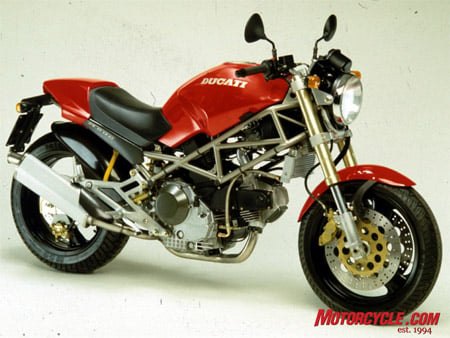 1992 Ducati Monster 900.
1993: The 904cc Monster with Desmodue engine (2-valve, air-cooled) is put into production. 1995: The Monster family expands with the introduction of the smaller 600cc model. 1996: The family is further expanded with the arrival of the 750cc model. 1998: The introduction of the Monster 600 Dark, Monster 900 Cromo and Monster 900 S. 2000: Technology and styling continue to develop. The latest arrival is the Monster 900 with EFI, and the styling of the entire range is updated. 2001: The evolution of sports models continues with the introduction of the Monster S4 with 916cc Desmoquattro engine and completely new running gear. 2002: EFI is introduced on the smaller models; the entry-level model now has a larger 618cc engine. All models benefit from the new running gear used on the S4. 2003: The Monster 800 and Monster 1000 are introduced, the latter equipped with the new Dual Spark engine. 2004: The flagship of the Monster range is introduced: the S4R with 996cc engine, single-side swingarm and totally revised styling and technology. 2005: The family grows with the arrival of the S2R powered by the 800cc Desmodue engine. 2006: The Monster S2R with 992cc engine is born. In addition, an authentic, no-compromise bike is introduced, the Monster S4R S Testastretta, a true naked Superbike with all the power and grunt of the Desmodromic "Testastretta" engine. 2007: The Monster family adds the new S4R Testastretta to its already impressive line-up. This new model is powered by the 130-hp Testastretta, deep-sump,L-Twin engine, previously powering only the top of the range S4R S. Another newcomer is the Monster 695 which replaces the entry-level 620. 2008: The Monster 696 is born.
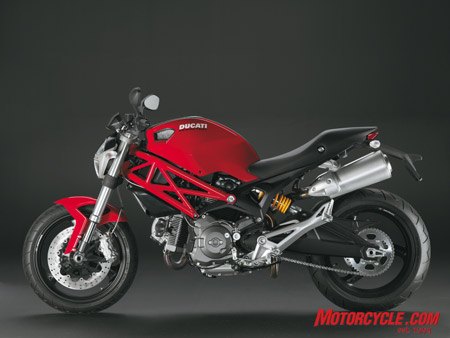 |
One carry-over from the 695 is Ducati's APTC (Adler Power Torque Clutch). Put simply, a slipper clutch. This little number works incredibly well, even better than a number of back-torque limiting clutches I've sampled on sportbikes with much bigger numbers: horsepower, torque and MSRP. Clutch action at the lever was feathery-light, albeit with a long throw that necessitates slipping the clutch from stops. As for the slipper, only once was I able to get the slightest wiggle from the back end after an aggressive three-gear downshift. Otherwise its action was virtually imperceptible and thereby brilliant!
Since gear ratios in the 6-speed box are unchanged we know that gearing is way too tall; thankfully the healthy amount of torque becomes usable as low as 2700-3000 rpm and is capable of overcoming the gearing deficit. A quick inquiry to the Ducati N.A. public relations good guy, John Paolo Canton, revealed that tall gearing is utilized to meet those pesky E3 standards.
When Editor Duke tested the 695 in late summer last year he commented that fueling was... Ah, let's just quote him. "[The] fuel mapping needs a compass." A man of few words, that Duke guy. Perhaps then the switch from Marelli to Siemens EFI spraying into the same 45mm T-bodies on the 696 has made a difference, as I found throttle response nearly flawless with only the slightest sputter at very low rpm. Beyond this, throttle response was as close to instant as you would want and fueling was smooth.
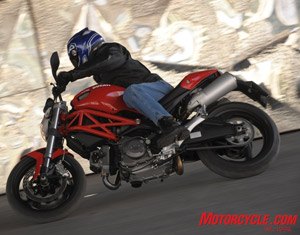
Spanish art in the background, Italian art in the foreground.
Another easy cue to the bike's redesign is the dual high-mount exhaust. The headers now snake up and behind the rear cylinder joining for a heartbeat in a short section of tube only to separate again into two canisters tucked just to the outside edge of the tailsection. This, says Ducati materials, helps keep heat away from the rider, aids torque and horsepower and keeps the area near the footpegs clutter-free so they (the pegs) can be closer together with the net effect being a trimmer bike at the center.
Speaking of trim, the 696 has an all-new fuel "tank." What you see ain't exactly what you get here. The plastic, or nylon resin, or whatever high-quality material that the faux tank is made from is 20mm shorter fore and aft than the previous model's tank resulting in what feels like a lower seat. The benefits, if not obvious, equal a shorter reach to the bars with a shape that welcomes shorter riders. Underneath the plastic you'll find the fuel cell with the airbox just fore of it. Because of the new location of each, both have their capacities increased by about one liter (3.8 gallons for fuel and 2.6 gallon airbox). What's really slick about this new arrangement is that both halves of the false tank can be removed, either for damage repair, or merely for you styling needs. Tired of the color scheme? Unbolt old, bolt-on new: voila! The astute reader will note one more nuance on the tank. The forward and upper portion has two small, screened cutouts that serve as intakes to the airbox while allowing the switchgear room to move at full steering lock that's increased to 64 degrees.
More standouts, some very important, include an LED taillight, an all-new ultra-compact "triple parabola" headlamp and single instrument (DDA) Ducati Data Analyzer-ready that "continues the tradition of all Ducati’s latest-generation hypersport models". At a glance, the digital tach is easily read and all info is toggled from one switch on the left switchgear. Unfortunately, it seems one thing hasn't changed for Ducati: the lack of an indicated redline.
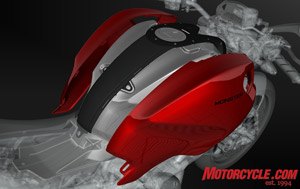
Here's how the false fuel tank can be disassembled for damage repair, or even to change the color of the tank if you wish.
City slick, canyon swift
For all my time as a motorcycle messenger in Los Angeles, I'm not sure I could fare successfully on my own in Barcelona's (everybody with me now, say it in Catalonian, Barthelona!) typically European surface streets. The lack of grid-like intersections, single-colored street markings and generally confusing interchanges, as much as it pains me to say this, had me frazzled. My cool exterior was blown, but not the Monster's. The new 696 is entirely at home and adept at city environs as much as it is on the highways or canyon roads. Its slim center and 15-pound claimed dry-weight savings (370 lbs vs. 355 lbs) makes dealing with stop-and-go traffic a simple chore, as putting your foot down at lights, or wherever, is a breeze.
After a few hairy urban moments our ride led us to the hills just outside of the former Olympic host city and soon we were in much more comfortable territory for me: undulating, tight passes. The compactness that creates a city-friendly mount also contributes to an absolutely brilliant canyon-carver. The 696's wide bars and narrow waist make transitioning from corner to corner nothing but a bunch of giggles as you search deeper and deeper into the bike's robust powerband, each turn coming a little quicker. The stout trellis-subframe-swingarm combo translates into an incredibly stable ride. This, along with the user-friendly engine, I can immediately proclaim to be a key characteristic of the new Monster.
Aiding the great chassis are new 43mm inverted Showa fork and a Sachs shock. I found nothing derogatory to say about the pairing of suspenders so wonderfully matched to the chassis.
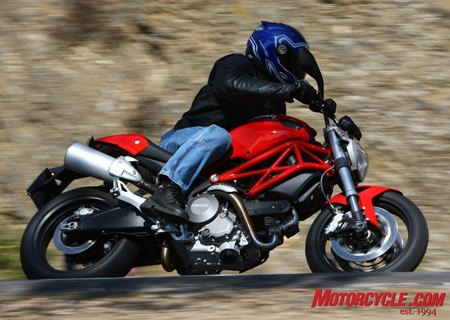
Braking componentry is equally as new and nearly as wonderful. Twin rotors (riding on Marchesini wheels of the same size as last year) grew by 20mm to 320mm; and instead of the same pair of dual-piston clampers from last year, the 696 receives a powerful set of radial-mount four-pot Brembos. Maybe different pad material might improve feel a little more on what are otherwise highly-capable brakes. But, hey, I'm a critic! Or is it cynic?
We don't live in a perfect world, and some would say, however trifle the complaints, the 696 isn't perfect. The mirrors, stylish though they are, aren't very functional. The field of view is too restricted, they're a bit buzzy and look to be cheap, plastic-y pieces. And though I didn't have an issue with the reach to the brake and clutch levers, I could be convinced that their lack of adjustability seems insensitive considering this Monster is clearly in the arena of many female riders who often have smaller hands than their dude counterparts. Additionally, thinking of lady passengers this time, the heat shield on the new exhaust cans is almost non-existent, potentially making for one unhappy guest.
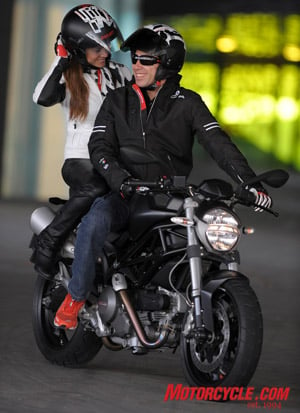
You'll be smiling too if you're buzzin' around on the new Monster 696, 'cause the ladies like 'em!
"It's a Monster!"
Like Giulio Malagoli, the Monster's lead engineer, said of his creation, "Isa one hundreda percenta Ducati. For sure-a it'sa Monster."
Ducati knows what butters its exotic bike bread, and for you, Monster fan, they've created the new 696 in a sharp new package. The improvements to the chassis, suspension and braking are complemented by a smartly revised mill, with the bike's looks and accouterments as most delicious icing on the cake.
If you're an experienced rider looking for a multi-tool ball-of-fun with loads of character, or a new or shorter rider, or a long-time devotee of this line of minimalist Italian bikes, be sure to get your deposit in soon, as my guess is that they'll be flyin' out the door faster than free cheese. Hopefully you’re the patient type, though, as the bike isn't slated to appear in the U.S. until June-ish '08 as a 2009 model. The 695 will complete its full production run during that time, so there'll be some overlap for awhile. When the 696 does hit American dealers, we'll be getting the model with pillion cover and little flyscreen as standard, all for $8775.
Look out, SV650 lovers. Those willing to pay will be ready to play!
| The Perfect Bike For... | ||
| Newbies, shorties, Ducatisti of all types, women or anyone who's always wanted a Ducati for everything the name represents. | ||
| Highs: | Sighs: | |
|
| |
Related Reading
2007 Ducati Monster 695
2008 Ducati 1098R Review
2007 Ducati Hypermotard 1100S
http://www.motorcycle.com/manufacturer/ducati/2009-ducati-monster-696-review-77793.html



Tidak ada komentar:
Posting Komentar